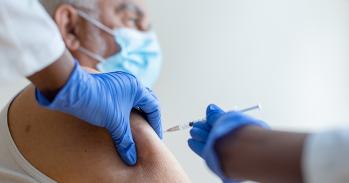
A new technique developed at the University of Cambridge allows researchers to identify clusters of proteins on immune cells which are key to fighting off the body’s invaders.
A new technique developed at the University of Cambridge allows researchers to identify clusters of proteins on immune cells which are key to fighting off the body’s invaders.
There are many problems in cell-biology where we would like to identify proteins that group together on the cell surface
Tony Jackson
When our bodies are under attack from foreign organisms, such as bacteria and viruses, our immune system orchestrates a complex fight-back involving many separate parts. One important component of this response is a type of cell called the B-lymphocyte – it is this cell that is at the forefront of our defence as it identifies and attempts to neutralise invaders.
The B-lymphocyte produces a protein called the B-cell receptor on its surface. The receptor recognises and attaches itself to molecules from the invading organisms, known as antigens. This triggers the B-lymphocyte to divide and to release specialised proteins called antibodies which neutralise the antigens.
There are many aspects of this process that are still not well understood. One reason is because the B-cell receptor does not exist in isolation on the B-lymphocyte surface. Rather, it forms localised clusters together with a number of ‘molecular neighbours’. It is these local interactions that control how the lymphocytes divide and replicate and determine the strength of the antibody response. A better understanding of these interactions could ultimately lead to better control of the immune response – for example in vaccine development. However, the molecular contacts within the clusters are relatively weak, and so they are technically difficult to identify.
Now, in an international collaboration, scientists at the University of Cambridge’s Department of Biochemistry, the Cambridge Centre for Proteomics and the Institute of Biophysics in Beijing have developed a technique that allows some of these molecules to be detected. The experiments were performed primarily by Li Xue-Wen in Beijing and Dr Jo Rees in Cambridge, and are published in the Journal of Biological Chemistry. The method enables proteins in the immediate vicinity of the B-cell receptor to be chemically tagged in such a way that they can be more easily isolated. The tagged molecules can then be identified using a method called mass spectrometry.
For this initial ‘proof of principle’ experiment, the researchers looked at the B-cell receptor on the surface of a chicken B-lymphocyte and identified molecules that were hitherto not thought to be involved in regulation of the receptor. They show that these molecules combine with the receptor to activate a class of proteins called integrins that are known to play an important role in the response of B-lymphocytes to antigens. Similar molecules occur on the human B-lymphocyte surface, and drugs active against integrins are already used to modulate the immune response. So a long-term implication of this work may be to identify new therapeutic targets for immune regulation.
Professor Sarah Perrett from the Institute of Biophysics said: “In applying this technique, we have addressed a particularly challenging issue: how do we identify weak and transient, but potentially important, interactions between membrane proteins, which are notoriously difficult to work with?”
Dr Tony Jackson from the Department of Biochemistry, University of Cambridge said: “There are many problems in cell-biology where we would like to identify proteins that group together on the cell surface, and our method could also be applied in these cases. It should therefore be of interest to a wide group of researchers in both the academic and industrial biomedical communities.”
Funding for the research included the Biotechnology and Biological Sciences Research Council, the Medical Research Council and the Wellcome Trust.
The text in this work is licensed under a Creative Commons Licence. If you use this content on your site please link back to this page. For image rights, please see the credits associated with each individual image.





